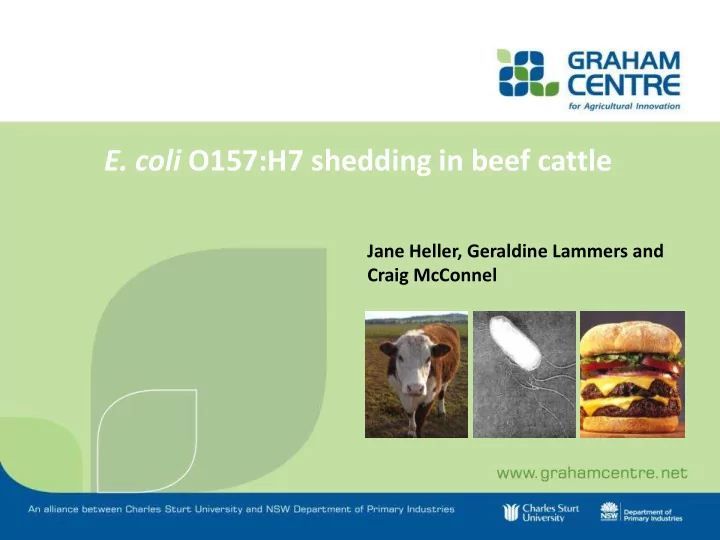

E. coli O157:H7 shedding in beef cattle Jane Heller, Geraldine Lammers and Craig McConnel
Overview Background on E.coli O157:H7 Supershedding of E.coli O157:H7 Overview of collaborative study - MLA Future research
Background • Escherichia coli are part of the normal flora in many animals • Most strains do not cause disease in humans • Some do cause disease - Shiga-toxin-producing E.coli (STEC) - Enterohaemorrhagic E.coli (EHEC)
Background • E.coli O157:H7 is the prototype EHEC serotype - it is the most commonly identified EHEC serotype worldwide • Other EHEC serotypes (the big six) - O26, O45, O103, O111, O121 and O145 - USA has required port-of-entry (POE) testing for E.coli O157 since 2002 and the big 6 since 2012.
E.coli O157:H7 • first identified as a pathogen in 1982 • commonly identified in outbreak investigations www.cdc.gov/nczved/dfbmd/disease_listing/stec_gi.html#3 • severe stomach cramps, diarrhea (often bloody), vomiting • incubation period ~3- 4 days (1−10 days) • minimum infective dose as low as 10 bacteria • ~5 – 10% of cases hemolytic uremic syndrome (HUS): – hemolysis, renal failure, death ~7 days post-exposure • very young children, the elderly more likely to develop HUS
E.coli O157:H7 • potential exposures: – contaminated food, non-disinfected water – contact with faeces of infected people – contact with cattle – recreational www.cdc.gov/nczved/dfbmd/disease_listing/stec_gi.html#3 high-risk foods unpasteurized (raw) milk soft cheeses from raw milk unpasteurised apple cider undercooked hamburger contaminated vegetables
STEC cases – incidence by country Cases / 100,000 Scotland (O157 only) 4.3 Ireland (O157 only) 3.9 New Zealand 3.3 Sweden 3.3 Canada (O157 only) 2.7 South Australia 2.4 UK (O157 only) 1.9 USA (O157 only) 1.12 South Australia (O157 only) 1.5 Australia 0.12
E.Coli O157 shedding in cattle • Variation between herds - Most, if not all, farms and feedlots have positive animals at some time - Estimates of prevalence in Australia range from 1.9 – 15% - Barlow et al (2010) • Factors associated with O157 carriage in cattle: - Young age, Diet, Season, Day length, Group housing, Transport
E.Coli O157 shedding in cattle • Variation between animals - Effect of individual animals on overall prevalence • Relatively few cattle responsible for the majority of E.coli O157 shed (Matthews et al., 2006)
E.Coli O157 shedding in cattle • Supershedding - when an animal sheds the pathogen at markedly higher levels than others (≥10 3 CFU/gram faeces) - risk factor for increased herd-level faecal prevalence, hide prevalence and hide load
E.Coli O157 shedding in cattle • Lack of longitudinal studies to track the within animal variation in shedding and quantity of pathogen shed • What factors, if any, contribute to the development of shedding, or to the occurrence of a supershedding event?
Project A.MFS.0247 • E.coli O157 colonisation and shedding in cattle - time frame April 2011 – April 2015 - review available microbiological techniques for detection - identify effective and efficient detection methodology - estimate frequency of occurrence and predictors of shedding and supershedding
Project A.MFS.0247 A. Literature review B. Technical training and pilot study C. Laboratory skills validation D. Longitudinal study E. Expert opinion exercise F. Simulation modelling G. National Forum
Project A.MFS.0247 – longitudinal study - Study individual and population transmission dynamics of E. coli O157:H7 - Identify and quantify risk factors for shedding Field work • October 2012 – June 2013 • Herd of 23 grass-fed Herefords
Methods Data collected Explanatory variables Individual variables Temperature, faecal consistency, hide contamination, weight, body condition score, faecal cortisol levels Environmental variables Rainfall, temperature, daylight duration, humidity, hours of sunshine Pasture type, quantity, quality Contamination of the drinking water Shedding (Y/N) Outcome variable
Results Descriptive results • 172/1326 (13.2%) positive samples • 152/172 (88.4%) <10 2 CFU per g of faeces • 10/172 (5.8%) between 10 2 – 10 3 CFU per g of faeces • 10/172 (5.8%) ≥ 10 3 CFU per g of faeces
Results cont. Proportion of Variable Category animals OR (95%CI) P value Faecal consistency 1 58/1335 2 860/1335 0.4 (0.14-0.98) 0.04 3 384/1335 0.5 (0.16-1.33) 0.16 4 33/1335 0.5 (0.13-2.24) 0.40 Calf-at-foot yes 588/1339 10.1 (4.02-25.44) <0.001 no 751/1339 Pasture quantity 0.997 (0.996-0.998) <0.001 1.04 (1.01-1.08) 0.02 Rainfall in previous week (ml)
Conclusion • First study to look at change in shedding in animals over a prolonged period of time • Faecal consistency, nursing, rainfall and pasture quantity are the 4 main factors associated with O157 shedding in this model - different to findings in dairy herd… • Day-to-day variability has a greater effect than cow-to-cow variability on O157 shedding - shedding is not more likely to occur from one individual than another
Conclusion • if this was true for supershedding as well it would support the fact that we should look to control supershedding events rather than supershedding animals • Remember this study was performed in a single herd and is subject to the variation in weather (or lack thereof) that occurred during the time period studied
Future research Short intensive study • Focus on the individual animal - allow reduced time intervals for data collection • Repeat longitudinal study in a population that allows identification of risk factors associated with supershedding
Future research Expert opinion exercise • Gather group of experts Simulation modelling • Include data that reflects within animal variation in previous models • Assess likelihood of identifying positive animal if it is present in the herd National Forum • Dissemination of results • Discussion about control
Acknowledgements • David Jordan • Michelle Ayton • Franziska Pilger, Ian Patterson, Saliya Gurusinghe • Jim Mellor, James Stephens, Tony Hobbs • Stuart Geard, Ashleigh Wildridge • Om Dhungyel • Karen Williams
Recommend
More recommend